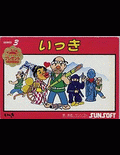































Ikki

Ikki is an arcade game originally released by Sunsoft in 1985. The game was released for the Famicom (Nintendo Entertainment System) on November 28 of the same year, and is a multi-directional scrolling action game which contains some elements of a top-down shooter. The game is known outside of Japan as Boomerang and Farmers Rebellion. Its main character, Gonbe, makes a cameo appearance in Atlantis no Nazo, another Sunsoft game.
The game has been ported to numerous other platforms, including the Microsoft Windows operating system as part of the Ultra2000 Sunsoft Classic games compilation, which was released on June 29, 2001. The game has also been coupled with Tōkaidō Gojūsan-tsugi and Yūyū Sunsoft kessaku-sen 2 (released July 2, 2004), and was coupled with Super Arabian for the PlayStation compilation Memorial Series Sunsoft Vol. 1. This compilation was also released for the PlayStation Network download service for the PlayStation 3, and also became available on Nintendo's Virtual Console in January 16, 2007 for the Wii, in February 13, 2013 for the Nintendo 3DS and in May 22, 2013 for the Wii U
The game is set in medieval Japan, where a poor farming village is planning an insurrection to overthrow their feudal overlord. However, the only participants in the revolt are the player's character, Gonbe, and the optional second-player character, Tago, and the player battles against an army of ninjas instead of samurai and foot soldiers. The game displays text in the vertical direction, which was very unusual for a game of the period, and all in-game messages use speech reminiscent of jidaigeki films.
The character's movement is controlled with an 8-way joystick, and pressing the single button allows the player to attack by throwing a sickle. The direction in which the sickle is thrown cannot be determined by the player, and the weapon will automatically head towards the closest enemy. This forces an emphasis on avoiding attacks rather than attacking aggressively. The right side of the screen displays the player's points, along with a map of the level. The location of koban coins is displayed on this map, but players must circumvent walls and other barriers to go to those locations. This map is not included in the Famicom version of the game.
Enemy characters include a black or red ninja, bomber ninja, and wild boar (some of these enemies do not appear in the Famicom version). Red ninjas move faster than all of the other characters and are harder to hit, but yield twice as many points. The player loses a life when they come in contact with any of the enemy characters or projectiles. The game ends when the player loses with no lives remaining. A ghost (or yōkai) will also appear on occasion, and the player will be unable to throw their sickle if they come in contact with it. The ghost's effect will dissipate if the player touches the jizō or komainu statues which are present on some levels. A grotesque handmaiden may also appear on some levels, and coming in contact with this handmaiden will prevent the player from moving for a short period of time. Though the player can still attack with the sickle in this condition, it becomes impossible to dodge enemy projectiles, making it very difficult to progress. The handmaiden character does not appear in the i-appli mobile phone version.
A level is completed when the player picks up all eight gold koban coins which are spread throughout the map, or if they capture the daikan (Japanese feudal lord) that can randomly appear during the level. There are eight levels included in the original game, and the Famicom version contains four levels, with four more secret levels where the location of the coins is changed. The player returns to the first level after all eight levels are completed. Completing the cycle twice ends the game in the i-appli version, but the player can continue the game indefinitely in the Famicom version by choosing to ignore the coins and concentrate on fending off the enemies.
The Famicom version consists of four different levels, with the fifth level being an alternate version of the first, the sixth being an alternate version of the second, and so on. The difficulty gradually increases as the game progresses, and the game levels loop infinitely. There is no ending screen for the game, and completion of level 99 brings the player to level 00, which is an alternate version of the fourth level. The player returns to level 01 after completing level 00. A 'secret letter' appears on-screen after each of the first 8 levels in the Famicom version. The secret letters displayed are E, R, A, W, T, F, O, S, in order, and if the letters are read backwards as indicated in the game's instruction manual, they form the word 'SOFTWARE.' This code word was required for the gift campaign that was conducted during the game's initial release.
How to play:
Click on the joystick icon in the Ikki online emulator to see how to control the Ikki game









































Comments